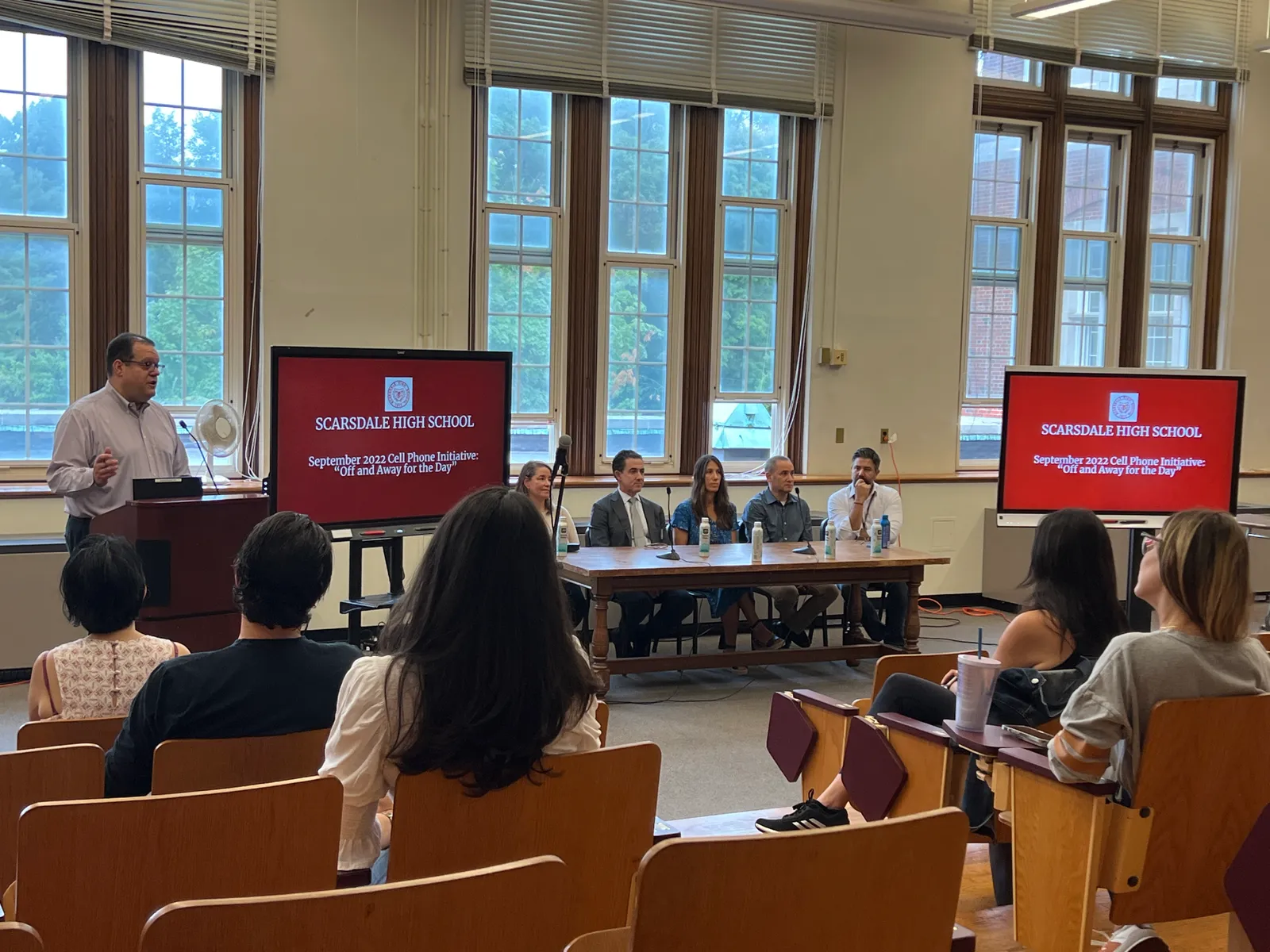High school is supposed to be socially awkward. The uncomfortable silences, the abrupt interruptions, the side glance at a first crush — all of that is part of teen’s journey into a more confident participant in unstructured social activities.
Cellphones, however, have become a security blanket to avoid face-to-face interactions. And even when the digital natives are comfortably among close friends, there's always someone staring at a screen.
Jennifer Rosenzweig, an English teacher at Scarsdale High School in New York, and other school staff are on a mission to significantly limit cellphone use at the school not just for the sake of students' social development, but for academic reasons too.
Called "Off and Away for the Day," the initiative started this school year at the 1,500-student, grade 9-12 school. It's not an outright ban but a tiered approach that calls for different cellphone use depending on what activity the student is doing.
Level 1 is for most of the school day when students are in classes and phones are off and stored in backpacks.
Level 2 is for when students are in homeroom, lunch or a common tutorial period, where they can briefly check phones if needed but can't use social media or be gaming or scrolling.
Level 3 is the "mindful" use of cellphones, reserved for when there's a free period. Students may use their phones to listen to music, a podcast or to meditate, but should not be using social media, scrolling or gaming.
Rosenzweig knows the lines between the levels can be murky: What defines "briefly"? Is it OK if a student scrolls to find a podcast? But she says "doing nothing is not an option."
"We can't teach a bunch of kids who are lonely and depressed," she said. "It's not their fault, because we've routed everything through their phones."
School cellphone pros and cons
Eight years ago, Rosenzweig and faculty in the English department noticed declines in reading skills, even among top-performing students. The staff set out to learn why. A study group was created to discuss books and research the correlation between screen time and loss of focus. The group learned about the growing rates of adolescent depression.

The school's wellness committee developed a video about the distractibility of cellphone use, along with a new policy limiting cellphone use in the school. They planned for an April 2020 launch date, having no idea a global pandemic would cause long-term closures of schools and force educators and students to use screens more than ever for remote learning and virtual socializing.
About 95% of U.S. teens, ages 13-17, have or have access to a cellphone, and smartphone ownership is nearly universal among teens of different genders, races and ethnicities, and socioeconomic backgrounds, according to a 2018 Pew Research Center study.
A 2019 Pew report found 54% of teens said they spent too much time on their phones, and 52% said they've tried to cut back on their use.
For school leaders, student cellphone use has been a headache that's been even harder to address as schools reopened fully during the pandemic. There are challenges to consistency with enforcement, and many teachers don't want to be the phone police.
Researchers, parents, educators and students cite pros and cons for cellphone use in schools. The benefits include students being able to quickly add photos to class projects, having easy access to their calendars, and — probably most importantly — the ability to communicate during an emergency. But the downsides include the potential for in-class cheating, increased distraction and social isolation.
'It's never too late'
The Scarsdale High School Wellness Committee weighed the benefits and downsides, too. It continued the research and discussions over the past two school years, noting that even when students returned after long school closures, they were using their cellphones more than before during the school day.
Rosenzweig said when students were asked at the end of last school year to reflect on three moments over the year, many said they had been lonely.
Committee members also noticed an increase in student anxiety and depression, and teachers said student focus was low. "There is a general sense of hopelessness about how to pull back our dependence and usage and create new norms," said a slide on a parent presentation for "Off and Away for the Day."
Deciding to kick off this new school year with the policy felt right, Rosenzweig said about two weeks after the first day of school. Since the start of the school year on Sept. 6, the committee has held two parent workshops and met with students to discuss the policy. The group also released a self-produced video featuring Scarsdale High School staff discussing the harms of cellphone addiction, as well as their own over-use.

Rosenzweig and Oren Iosepovici, director of counseling at Scarsdale High, said support from administrators was key to helping the initiative move forward.
They said so far, students, staff and parents have reacted positively to the new phone policy. Staff are noticing students engaging with each other more and using their cellphones less.
"Anecdotally, people are seeing a change," said Iosepovici. "Again, it's really early. I don't want to overemphasize that, but people are definitely seeing a change in terms of student habits."
The focus now is maintaining momentum. There are plans to hang posters around the building and have a visit from an ice cream truck to incentivize compliance. The wellness committee also plans to measure the initiative's impact by gathering feedback from the student government, teachers and parents.
"Wherever we start, it's OK. It's never too late," Rosenzweig said. "We're off to a great start, and there's so much work to do."






















